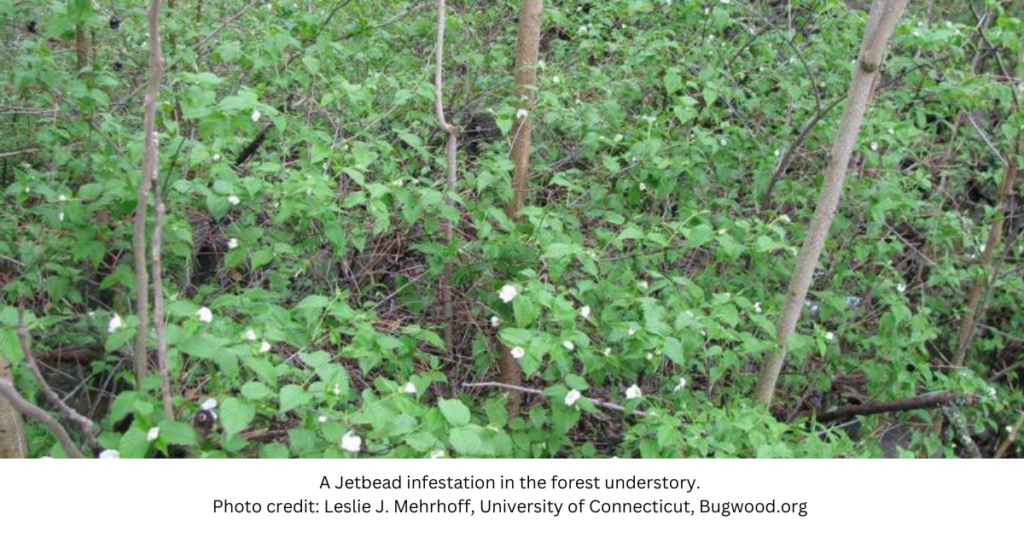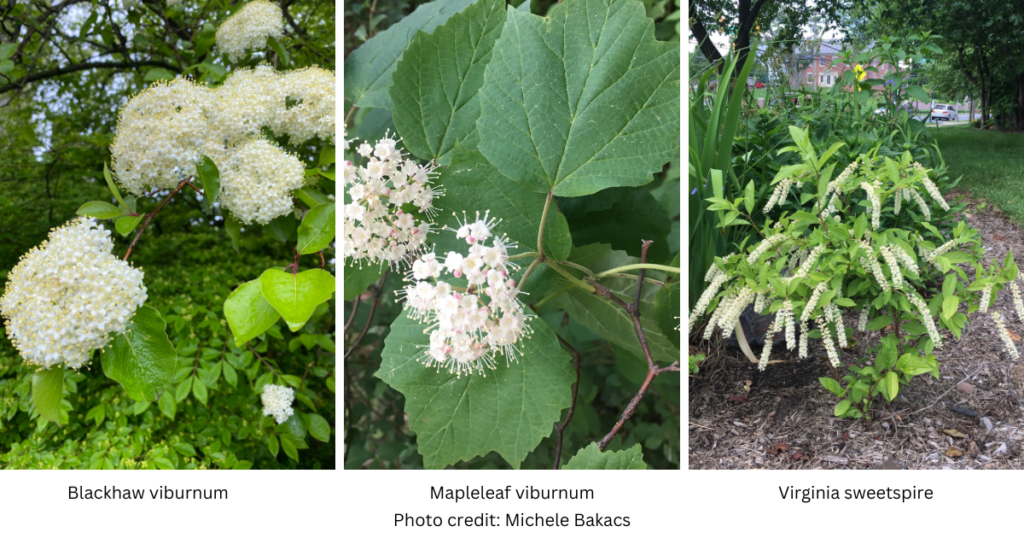Main Content

Jetbead, Rhodotypos scandens
Jetbead is an invasive spring flowering, deciduous shrub. It is available as an ornamental and spreads into understory forests and roadsides. Its attractive white flower starts blooming in April making it easy to identify this time of year. Jetbead can grow in both full sun and shade. Due to its tolerance of a wide range of conditions it can displace native shrubs that wildlife depend on for high quality habitat.
Description: Jetbead is a multi-stemmed shrub that grows up to 6 feet. The simple, bright green leaves have an opposite arrangement along the stem and are doubly toothed. The spring terminal flowers are white with four large petals and 4 toothed sepals. The fall is the second-best time to identify this shrub as the fruit is a cluster of four black, shiny drupes at the branch tips that start to appear in September. Some sources indicate that Jetbead fruit is severely toxic to humans as it contains Amygdalin, a cyanogenic glycoside.
Ecological threat: This invasive shrub displaces native vegetation in the shrub layer, which then stifles natural species succession and reduces resources available for wildlife. Deer do not eat it as they prefer the native vegetation.

Method of spread: Jetbead spreads by seeds eaten and dispersed by birds. It is also commercially available and spreads from horticultural plantings. It appears to spread via sprouts, forming an outwardly expanding colony.
Removal method: For manual control, when infestations are small, shrubs can be dug up by the roots. Roots will re-sprout if left in the ground and repeated cutting is needed throughout the growing season as new growth appears. DO NOT compost the seeds or cuttings. For larger infestations, shrubs can still be cut but will most likely need to be followed up with foliar spray when shrubs start to grow back. Early detection/rapid response is the ideal method for control; learn to identify this shrub in small seedling stages and monitor at-risk locations regularly.
For chemical control, foliar applications with glyphosate are effective as is cut-stump treatments in the fall and winter. Basal bark treatment applied between July and September is very effective. Always follow the herbicide label instructions; the label is the law. Post treatment, make sure to monitor the area for re-sprouts and new individuals for multiple seasons. Information about seed viability is limited.
If you are not able to use or comfortable with using herbicides, but have a Jetbead invasion that needs attention, hire a landscape professional that has a pesticide license and specializes in invasive plant management.

Native alternatives: Do not plant Jetbead. New Jersey has many native flowering shrubs that have white clusters of flowers in the spring.
Maple-leaved viburnum, Viburnum acerifolium does well in part shade and moist to dry, acidic upland soils.
Blackhaw viburnum, Viburnum prunifolium thrives in part shade with moist soil, but can tolerate sunnier conditions and some drought.
Arrowood viburnum, Viburnum dentatum does well in part shade and dry conditions but can tolerate full sun. It is deer resistant.
Redosier Dogwood, Cornus sericea does well in full sun with moist soil but can tolerate part shade and drier conditions. It has two seasons of interest with beautiful white flowers in the spring and red stems in the winter.
Virginia sweetspire, Itea virginica thrives in part sun in acidic moist to wet rich soils; it can tolerate mostly sunny conditions to shade and some drought. It has two seasons of interest with beautiful white flowers in the spring and deep purple, red fall color.
Thank you to our reviewers: Mike Van Clef, Jean Epiphan, and John Landau.
Additional resources for native alternatives and controlling Jetbead:
Invasive Plants and Native Alternatives for Landscapes
New Jersey Invasive Species Strike Team Fact Sheets
Lower Hudson Partnership for Regional Invasive Species Management
North Carolina Extension Gardener Plant Toolbox
The goal of Rutgers Cooperative Extension’s “Invasive Species of the Month” is to highlight those organisms that are non-native to New Jersey and cause economic or environmental harm, or harm to human health. We can all help prevent the spread of invasives by learning which species are a threat to our ecosystems.